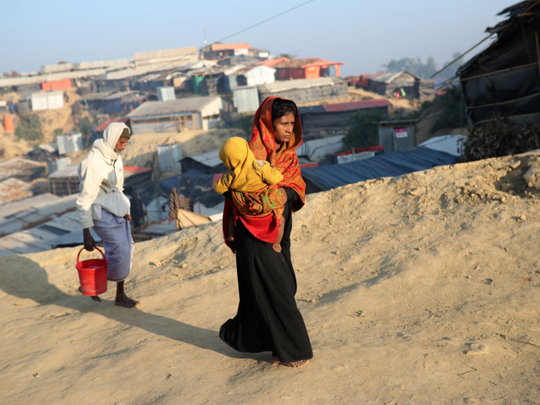
Myanmar: Cox’s Bazar Nazima Begum watches as a strip of paper with green, yellow and red bands is placed around her baby’s upper arm. If the circumference falls in the green zone, that’s good. If it falls in the red, it’s dangerous.
Her seven-month-old son, Ataur Rahman, is firmly in the danger zone. The circumference of his arm is 85mm. Anything below 110mm indicates severe malnourishment and risk of death. He weighs 4.2kg and is just over 60cm in length. The World Health Organisation estimates the average weight and height for a seven-month-old boy is 8kg and 69cm.
If Begum hadn’t brought him to the outpatients centre just outside Cox’s Bazar, he could have been dead within a week.
Begum tells staff that she’s struggled to feed Ataur since they arrived in Bangladesh in September, because she’s not been able to produce enough breastmilk. “Now I only have a very small amount,” she says.
It is a common complaint among women visiting the Action Against Hunger centre at Hakimpara makeshift camp, opened last year following the mass exodus of Rohingya from neighbouring Myanmar.
Jamaliba (who only goes by one name) has brought her daughter, Remas, to the centre. The one-year-old has had diarrhoea for a few days and her mother is worried she’ll become severely malnourished. It would not be the first time; she was last there three months ago.
Jamaliba has been breastfeeding her daughter, but the amount of milk she has produced over the past month has been very low, and Remas has lost weight.
Begum and Jamaliba, along with their families, fled their homes in Myanmar’s Rakhine state in September. They are among almost 700,000 Rohingya who, having fled violence in the area since August, are now living in camps near Cox’s Bazar. Begum left with her husband, mother, sister-in-law and two children. Jamaliba fled with her husband and four young children.
In November, the UN children’s agency, Unicef, warned that one in four Rohingya children in Bangladesh were severely malnourished.
To ensure good development, the WHO and the UN refugee agency, the UN High Commissioner for Refugees, recommend exclusive breastfeeding for at least the first six months of a child’s life, then continued feeding with solids until the age of two. But in times of crisis, when breastfeeding becomes even more important for children, women can struggle to produce enough milk. There can be various reasons for this. Sometimes children become ill and are too weak to suckle. Sometimes the mother hasn’t enough nutritious food herself. Or there might be nowhere private to feed. In Hakimpara camp, however, a significant reason for not producing milk is the emotional trauma that comes with displacement.
“Usually in a month, we see 10 to 15 mothers [at the camp] experiencing difficulties breastfeeding their children that are related to trauma,” says Sukla Sarkar, a nurser supervisor with Action Against Hunger.
“Even if a mother is malnourished or eating less, she should be able to produce milk to feed her baby.”
Most cases Sarkar has seen relate to family issues — women not being able to connect with their babies or take care of themselves properly. “[They are] related to displacement,” she says. “In Burma, women are living together in families, but now women are living with their parents, or their husbands are somewhere else, and they are dealing with stress and trouble. If a woman has older children, there are tensions about how to feed and look after them. It builds up.”
To support women, Action Against Hunger offers specific counselling sessions for those having trouble breastfeeding. The organisation helps them try to relactate or invites them to discuss alternatives, such as using formula.
In a curtained-off room in a tarpaulin shelter in Hakimpara camp, women are first assessed to see if there are any physical reasons for the problems, such as a blockage in the milk duct. If nothing is found, they are encouraged to attend weekly meetings with trained counsellors. There, they can talk about their experiences and perhaps learn to reconnect with their children. Sarkar says three to four sessions are usually enough to trigger signs of improvement.
Begum and Jamiliba were invited for counselling, while their children were put on the nutritional supplement Plumpy’nut, a highly nutritious peanut paste given to severely malnourished children over the age of six months. They will be monitored weekly.
Counselling helped Hamida Begum, 30, who was forced to flee her home last year after her village was attacked by Myanmar forces and her husband was killed. She was pregnant with her third child at the time. She arrived in Bangladesh in September after her son, Abdullah, was born. By the time they arrived, he was severely malnourished and she was unable to produce milk.
“I didn’t find any problem breastfeeding the first children, but this one I couldn’t breastfeed,” she says, sitting outside her tarpaulin tent on the slopes of Hakimpara camp. Abdullah was given Plumpy’nut and Begum received counselling. “Two months ago the baby was very weak and not well,” she says. “Now I feel the baby is playing and more lively. He’s laughing.”
— Guardian News & Media Ltd












